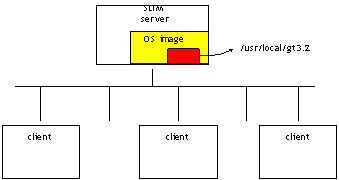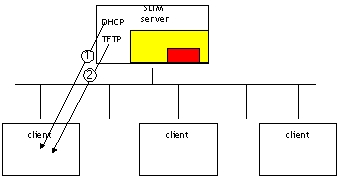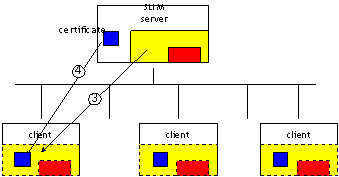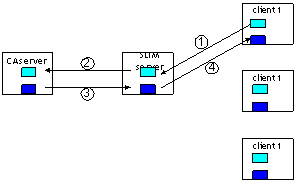|
|
|
|
Elastic Private Cloud Management Framework
(SLIM-VM)
|
|
Cloud computing technology has become the trend in both academic
and IT industry in recent years. There are two types of cloud:
public cloud and private cloud. A public cloud provides the
services for anyone through internet; this implies users need to
store their data at the remote ends rather than storing them
locally. However, for security reasons, a lot of organizations
and enterprises choose to build their private clouds to host
their data and applications for internal use only. Data center
administrators often face the situations that many user parties
request for cluster use while there are insufficient physical
machines to entertain them. On the other hand, some powerful
server nodes may see underutilization if allocated to only one
user at a time. Instead of allocating at coarse-grained per-node
basis, we built an Elastic Private Cloud Management Framework to
greatly simplify the management work. Using such a framework, we
can satisfy the requests from several parties simultaneously
while also improving the utilization of the cluster. The system
provides a centralized way for the administrator to manage
multiple virtual clusters (v-clusters) sharing the same
underlying physical resources. Due to good isolation of
virtualization technology, the end users are not aware that the
machines are indeed being shared with others. The system is of
several capabilities that simplify the management work:
SLIM Core Components
-
Centralized
and application-centric software management. All OS
images and grid middleware are stored and managed in a central
InstantGrid server. These software components are grouped into
distinct, pre-defined, EE’s; each EE targets at a specific
type of applications. For example, service-oriented
distributed applications and job submission-based HPC rely on
two very different EE’s. This model guarantees well-defined
EE’s for (and hence compatibility with) various grid
applications. The centrally managed EE’s are disseminated to
the compute nodes on-demand through the network, according to
the application requirements.
-
Proactive
software configuration. Instead
of installing and configuring OS’es and middleware
incrementally after they are disseminated to the compute
nodes, all software components in a specific EE are required
to be pre-configured in the InstantGrid server. In other
words, software would not be disseminated to the compute nodes
unless all of them are ready to be executed to form the
desired EE. These approaches shorten the time in composing and
switching between EE’s.
-
Performance
optimization techniques. The centralized management
model implies an entire EE (which could be as large as a few
gigabytes) has to be disseminated to the compute nodes
on-demand. While replicating all files is obviously
impractical, the existing network booting approaches which
completely rely on the network file system (NFS) would result
in poor runtime performance. We aim to address this problem by
exploiting efficient I/O caching techniques to avoid excessive
file transfer. In addition, the discriminative file sharing
mechanisms select the suitable strategy (e.g., NFS-shared,
replication, etc.) according to the usage pattern of a file,
which optimizes both the dissemination and runtime
performance.
-
In-memory
execution mode. We aim to cater for a scenario in
which the data/OS stored in the permanent storage in the
compute nodes would not be altered (or even accessed) when an
EE obtained via the network executes, i.e., a complete
in-memory operation. This is especially useful for supporting
grid computing in existing cluster platforms, desktop/home
computers, and diskless blade servers.
SLIM Working Mechanism
|
 |
 |
|
1. Software installation at
SLIM server |
2. Client boots and obtains kernel |
|
 |
 |
|
3. OS image/App disseminated |
4.
Process to generate certificates |
With Single Linux Image Management
(SLIM), administrators can boot a large number of physical machines
with customized OS and execution environment. "One-Click Virtual
Clusters" feature allows you to create a v-cluster
instantly. The
system guarantees performance isolation between different
v-clusters running on the same physical host via adavnced
isolation techniques. With live migration of virtual machines, we can easily
achieve dynamic load balancing and consolidation to maximally
utilize physical resources.
|
|
|
|

|
|
GUI for VM Management
|

|
|
Publication:
-
Roy S.C. Ho, K.K. Yin, David C.M. Lee,
Daniel H.F. Hung, C.L. Wang, and Francis C.M. Lau, ``InstantGrid: A Framework
for On-Demand Grid Point Construction,'' The International Workshop
on Grid and Cooperative Computing (GCC 2004),
pp. 911-914,
Oct 21-24, 2004, Wuhan,
China. (pdf)
-
Roy S.C. Ho, David C.M. Lee, Daniel
H.F. Hung, Cho-Li Wang, and Francis C.M. Lau, "On Managing Execution
Environments for Utility Computing,'' Proceedings of Network Research
Workshop 2004, 18th Asia-Pacific Advanced Network Meetings (APAN 2004),
Cairns, Australia, July 6, 2004, 175-182. (pdf)
|
|
|
|